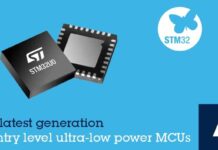
STMicroelectronics Updates TouchGFX Suite to Elevate User Interfaces and Reduce Memory and CPU Needs in STM32 Microcontrollers
STMicroelectronics has updated the TouchGFX user-interface software framework for STM32 microcontrollers, adding new features that enable smoother and more dynamic user interfaces and lower demand on the memory and CPU.
TouchGFX is a free tool in the STM32 ecosystem. Comprising two parts — TouchGFX Designer PC tool for designing and configuring rich user interfaces, and TouchGFX Engine software that runs on the end-device to secure high UI performance — the latest version 4.12 contains updates to both. Users can now build sophisticated user interfaces on one-chip display solutions without external RAM or flash, save power for longer battery life, and benefit from easier development to get to market faster.
In TouchGFX Engine, a partial framebuffer mode now allows the buffer to operate using as little as 6KB of RAM. A fully functioning user interface can now have just 16KB of RAM, so that small STM32 MCUs can deliver great user experiences without external memory. Also new, 8-bit luminance (L8) with 16-bit, 24-bit, and 32-bit palettes reduces demand for flash memory. Even with this smaller memory, TouchGFX maximizes performance by leveraging the STM32 Chrom-ART Accelerator to accelerate graphics and handle sophisticated effects. There is also a new cacheable container with dynamic bitmap that reduces CPU loading to run smooth and fluid animations at high frame rates.
Users can also now choose 6-bit color depth, which saves both RAM and flash while making 64 colors available for creating entry-level GUIs. Support for external non-memory-mapped flash is also new and helps build basic user interfaces within tight system resources.
The updates to TouchGFX Designer include extensions to the powerful set of customizable widgets, adding features such as Scale and Rotate that increase the power of simple drag-and-drop programming. Custom triggers and actions reduce reliance on coding to create sophisticated features, and a new Image tab lets users quickly configure individual attributes such as image format, dither algorithm, and layout rotation. There are also performance improvements that accelerate automatic code generation and reduce loading time, as well as new easy-to-use functions for guiding text, such as bring-forward and send-to-back.
The complete TouchGFX Suite, including TouchGFX Designer and TouchGFX Engine, is available to download free of charge from www.st/com/touchgfxdesigner.


















